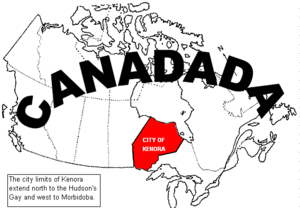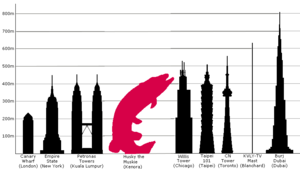Kenora
Kenora is a city in northwestern Ontario. Its metropolitan area is the second largest in the world at 480,880 sq. km. (Vilna, Lithuania ranks first and is the only metropolitan area larger than the country in which it is situated.) Kenora's metro area is bounded on the west by Morbidoba, extends north to the shores of the Hudson's Gay, bordering the rest of Ontario on the east, and Minnesota to the south.
Metro Kenora is home to 9,738 people (9,346 who are homosexual lumberjacks), 34,680,220 horseflies, twice as many mosquitoes, and the world's largest troupe of Forrest Gump impersonators.
History[edit | edit source]
The Early Years: Kenora was accidentally founded in 1886 by a wandering band of ice bowling goaltenders. Pierre Burton Cummings, Canadada's only historian, explains the incident in his seminal work, "Canadada, the Canadadian Pacific Railway, and Other Tales of Mass Murder":
- "Upon its maiden voyage west from Fort William, old Engine 9021 clanged and chuffed like a zebra in extreme pain, rolled quicker and quicker with each statute mile, laden with cargo and ice bowling goalies, rocketing with muffled genius towards the setting sun, choof-choofing through blastereened defiles of black Precambrian rock, swooping gracelessly trailing a billow of gut-wrenching soot and steam, flonkering around the curve through a maze of half-surprised, half-stunned, half-witted tracklayers, and hurdled effortlessly off the unfinished line, ploughing into the bottomless muskeg, with a resoundingly violent explosion and much loss of life.
- The goalies survived the crash but they had to continue westward on foot."
Upon reaching the site of the modern Kenricia Hotel, the goalies had to stop as most of them had lost all feeling in their feet due to frostbite. A untrained surgeon named Oswald Ranke arrived later by floatplane and began the arduous task of arbitrary amputations. The thankful crowd of newly legless goalies named the site Kenora--an anagram of Mr Ranke's first initial and last name.
The Great Newspaper Delivery Boy Invasion: Before the turn of the nineteenth century, goalies and prospectors diversified into alcoholism and inspired debate. As the economy declined, rival gangs of paper delivery boys descended on the community in droves. By 1900, lawless gangs of paperboys ruled supreme on the dusty streets of the bustling town. The next year, in March, the rail line from Fort William was completed, the first women arrived in Kenora, and newspaper readership declined disastrously. This ended the Great Newspaper Delivery Boy Invasion.
Discovery of the Lake of the Woods: In early 1902, the nearly-permanent ice and snow cover receded slightly on July 28 to reveal the settlement was situated on a lake. Joanne and Herbert Woods, who had built a cabin on the ice one year earlier, found themselves adrift as the weather briefly improved. They elected to swim for the nearest shoreline rather than wait for the monthly ice blizzard to refreeze the open water. The lake was posthumously named in their honour.
Other Notable Dates in Kenora's History[edit | edit source]
- 1906: Kenora Thistles, the local ice bowling team, wins the Stanley Cup.
- 1928: Horsefly Taming Club opened for membership. Rotary Club closes its doors.
- 1967: Erection of Kenora's tallest free-standing structure, 'Husky the Muskie'.
- 1972: The town's first escalator installed inside statue of 'Husky the Muskie' to assist visitors to the top.
- 1993: Horsefly-taming declared illegal by provincial statute.
- 1998: Kenora amalgamates with Fort Frances, Dryden and Sioux Lookout to create metropolitan Kenora.
Climate[edit | edit source]
References in Popular Culture[edit | edit source]
- R.E.M: "What's The Frequency, Kenora?"


